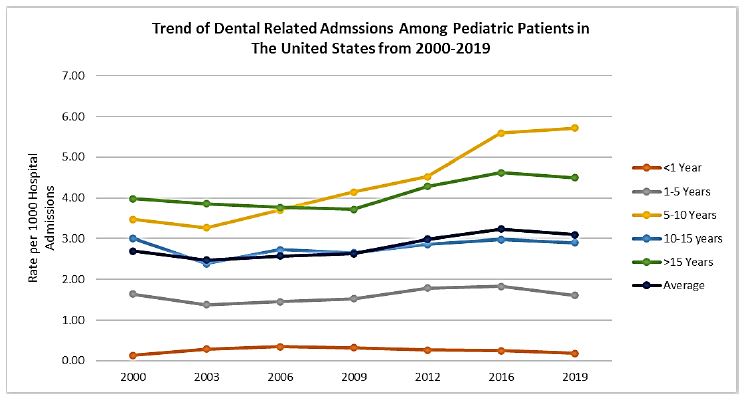Public Health & Prevention
Public Health & Prevention 3
342 - Trends and Socio-Economic Factors Predicting Dental Related Admissions in Pediatric Population in the United States: A Perspective from KID National Database
Monday, May 1, 2023
9:30 AM - 11:30 AM ET
Poster Number: 342
Publication Number: 342.447
Publication Number: 342.447
Chintan Desai, Mississippi State Department of Health, Jackson, MS, United States; Aditya S. Patel, Jackson State University, Jackson, MS, United States; Nilesh Dankhara, University of Mississippi Medical Center, Jackson, MS, United States; Jagdish Desai, Pediatrix Medical Group, Austin, TX, United States
- CD
Chintan Desai, Master of Public Health (he/him/his)
Mississippi State Department of Health
Jackson, Mississippi, United States
Presenting Author(s)
Background: Untreated dental disease can significantly impact systemic health and may result in costly hospitalizations. The burden of dental-related hospital admissions in the pediatric population in the United States has not been reported previously, mainly focused on socioeconomic factors affecting it.
Objective: Objectives of this study are (i) Describe the trend of dental-related admissions from 2000 to 2019 in pediatric populations and (ii) Study socio-economic factors predicting dental-related admissions in this cohort.
Design/Methods: We accessed the national multicenter Kids’ Inpatient Database (KID) Healthcare Cost and Utilization Project (HCUP) from the years 2000 to 2019. We excluded encounters with neonatal/newborn admissions. Dental-related admissions were identified with primary/admitting diagnoses of ICD-9 (520.0‐529.9, 792.4, 784.92, 802.2‐802.5, 873.6‐873.79, V52.3, V53.4, V58.5, V72.2, V45.84) and ICD-10 codes (K00-K09), respectively, for the years 2000-2012 and 2016-2019. A logistic regression model was performed to identify socioeconomic factors affecting dental-related hospitalizations. Weight-based analysis was performed using SAS 9.4 for complex sample design.
Results: A total of 21,497,670 pediatric admissions were analyzed in this cohort. The prevalence of dental-related admission was 2.7 cases per 1000 pediatric admissions. The trend for hospitalization is presented in Figure 1. The average admission rate was stable overall in years, but an increasing trend was found in the age group of 5-10 years. When looking at the top 10 reasons fordental-relatedd admissions, the periapical abscess was the most common reason, followed by maxillary hypoplasia (Figure 2). A statistically significant upward trend was found in the admission rate due to periapical abscesses and maxillary hypoplasia. In contrast, a downward trend was noted in jaw-cranial base diseases and maxillary hypoplasia anomalies. In a regression analysis, factors predicting dental-related admissions were age >10 years, male gender, white race, Private Insurance, higher median household income ( >50th percentile), urban location, and living in northeast states (Figure 3).
Conclusion(s): To our knowledge, this is the largest cohort based on a national multicenter database analyzing pediatric dental-related hospitalization. An increasing trend in periapical abscess admission is a concern as it is a preventable cause and can increase healthcare costs if not addressed. Targeted educational and preventive strategies should be carried out toward identified high-risk socio-economic factors.

.jpg)
.jpg)
